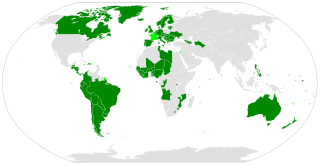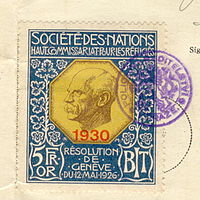
Fridtjof Wedel-Jarlsberg Nansen was a Norwegian polymath and Nobel Peace Prize laureate. He gained prominence at various points in his life as an explorer, scientist, diplomat, humanitarian and co-founded the Fatherland League.
The Office of the United Nations High Commissioner for Refugees (UNHCR) is a United Nations agency mandated to aid and protect refugees, forcibly displaced communities, and stateless people, and to assist in their voluntary repatriation, local integration or resettlement to a third country. It is headquartered in Geneva, Switzerland, with over 18,879 staff working in 138 countries as of 2020.
Fridtjof Nansen (1861–1930) was a Norwegian polar explorer, scientist, diplomat, humanitarian, and Nobel laureate.
In international law, a stateless person is someone who is "not considered as a national by any state under the operation of its law". Some stateless people are also refugees. However, not all refugees are stateless, and many people who are stateless have never crossed an international border. At the end of 2022, the United Nations High Commissioner for Refugees estimated 4.4 million people worldwide as either stateless or of undetermined nationality, 90,800 (+2%) more than at the end of 2021.

A certificate of identity, sometimes called an alien's passport, is a travel document issued by a country to non-citizens residing within their borders who are stateless persons or otherwise unable to obtain a passport from their state of nationality. Some states also issue certificates of identity to their own citizens as a form of emergency passport or otherwise in lieu of a passport. The visa requirements of certificates of identity may be different from those of regular passports.

The Nansen International Office for Refugees was an organization established in 1930 by the League of Nations and named after Fridtjof Nansen, soon after his death, which was internationally in charge of refugees from war areas between 1930 and 1939. It is noted for developing the Nansen passport which allowed stateless people to travel between countries. It received the Nobel Peace Prize in 1938.

The Hong Kong Certificate of Identity (CI) was a formal travel document and passport, issued by the Hong Kong Government's Immigration Department until 30 June 1997. It is no longer possible to possess a valid CI as a travel document, as all CIs have expired by 30 June 2007, though most CI holders should be eligible to hold the HKSAR Passport.

A travel document is an identity document issued by a government or international entity pursuant to international agreements to enable individuals to clear border control measures. Travel documents usually assure other governments that the bearer may return to the issuing country, and are often issued in booklet form to allow other governments to place visas as well as entry and exit stamps into them.

A refugee travel document is a travel document issued to a refugee by the state which they normally reside in, allowing them to travel outside that state and to return there. Refugees are unlikely to be able to obtain passports from their state of nationality and therefore need travel documents so that they might engage in international travel.

A 1954 Convention travel document is a travel document, unlike a Stateless travel document, issued to a person in circumstances of any difficulties in gaining a travel document from their country of origin. The cover bears the words travel document in English and French along with the date of the convention, but does not bear the two stripes appearing in the upper right corner of the front cover of refugee travel documents. However, some countries such as Australia and Japan issues stateless persons travel documents with other names such as Certificate of Identity or Re-entry Permit, etc., regardless of whether the country is a contracting state of 1954 Convention.

The Convention on the Reduction of Statelessness is a 1961 United Nations multilateral treaty whereby sovereign states agree to reduce the incidence of statelessness. The Convention was originally intended as a Protocol to the Convention Relating to the Status of Refugees, while the 1954 Convention Relating to the Status of Stateless Persons was adopted to cover stateless persons who are not refugees and therefore not within the scope of the Convention Relating to the Status of Refugees.

The New Zealand Certificate of Identity is an international biometric travel document issued by the Department of Internal Affairs to an alien resident of or visitor to New Zealand who is unable to obtain a national passport, or has a national passport unacceptable to Immigration New Zealand so that they can leave New Zealand. It is not usually issued to a person whose government is represented in either New Zealand or Australia.

The Canadian Certificate of Identity is an international travel document issued by Immigration, Refugees and Citizenship Canada to a permanent resident of Canada who is not yet a Canadian citizen, is stateless, or is otherwise unable to obtain a national passport or travel document. It is a biometric document with a grey cover and is bilingual in both English and French. The validity period of the travel document is determined by the issuing office.

Mandatory Palestine passports were travel documents issued by British authorities in Mandatory Palestine to residents between 1925 and 1948. The first brown-covered passport appeared around 1927, following the issue of the Palestinian Citizenship Order, 1925. From 1926 to 1935 alone approximately 70,000 of such travel documents were issued.

The Japan Re-entry Permit is a travel document similar to a certificate of identity, issued by Japan's Ministry of Justice. It is a passport-like booklet with a light brown cover with the words "再入国許可書 RE-ENTRY PERMIT TO JAPAN" on the front.

The Re-entry Permit is a travel document similar to a certificate of identity, issued by the United States Citizenship and Immigration Services to U.S. lawful permanent residents to allow them to travel abroad and return to the United States. It is a green passport-like booklet with the words Travel Document, a symbol, and other official wording in blue-gray. Individuals whose application for permanent residency has not yet been approved can apply instead for advance parole.
Humanitarian visas are visas granted by some countries in order to fulfill their international obligation to protect refugees from persecution. The criteria in the Convention Relating to the Status of Refugees are often used in assessing whether or not there is a legitimate claim for protection. It defines a refugee as a person who:
An Indian Identity Certificate, simply known as Identity Certificate (IC), is a travel document issued by the Passport Seva, Consular, Passport & Visa (CPV) Division of the Ministry of External Affairs, Government of India to non-citizens of the Republic of India for foreign travel. It enables the bearer to travel internationally and serves as proof of identity as per the Passports Act (1967). It is mostly issued to Tibetan refugees, along with other stateless people. Since 28 June 2016, Sweden is no longer accepting the Indian Identity Certificate as a travel document. However, on 9 October 2018, Sweden started accepting the Indian Identify Certificate for Tibetan Refugees on the condition that they have no objection to returning to India.
The nationality law of Bosnia and Herzegovina governs the acquisition, transmission and loss of citizenship of Bosnia and Herzegovina. Regulated under the framework of the Law on Citizenship of Bosnia and Herzegovina, it is based primarily on the principle of jus sanguinis.














